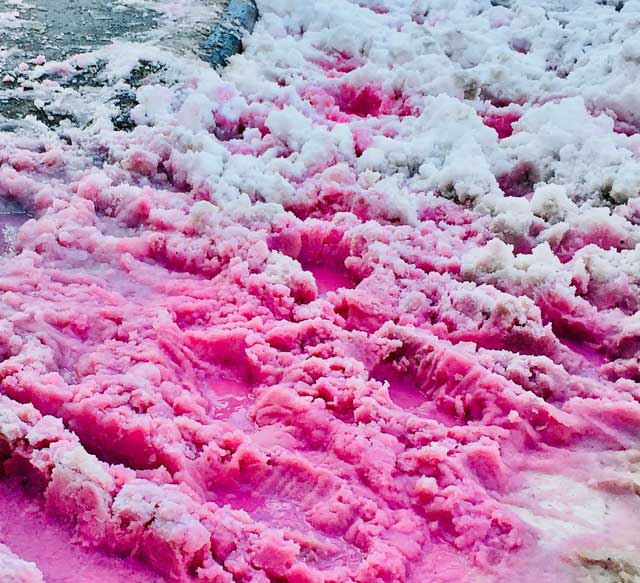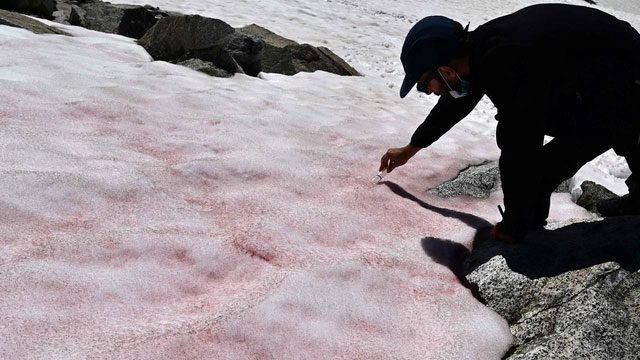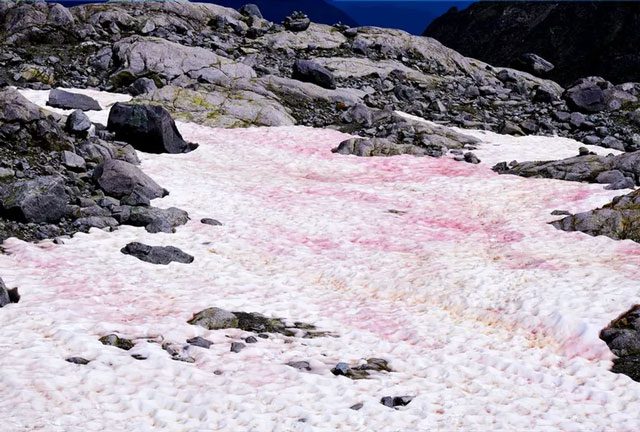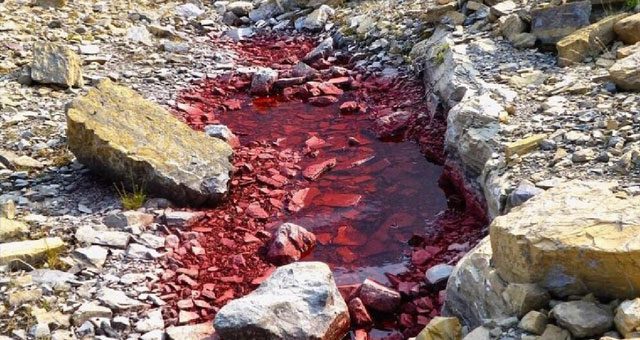While tourists are searching for towering rock faces or wildlife to photograph at Clements Mountain in Glacier National Park, Montana, USA, Jim Elser is focused on one thing: searching for pink snow.
Traversing colorful wildflower patches, this ecologist and his research team climbed high until they reached the peak of a slope. A soft buzzing sound began to emanate from the bulky rectangular device strapped to his colleague Joe Giersch, an aquatic entomologist at the University of Montana. This device was powering up to prepare for the scientists’ data collection work.

The phenomenon of pink snow caused by the blooming of Chlamydomonas nivalis algae.
Then, the three scientists noticed a faint pink stain on the thick layer of snow about 100 meters away, and they began to head towards it.
Red algae stretched across a sunny slope, covering an area of 37m2—this was Chlamydomonas nivalis, a red-pigmented algae typically found in high-altitude and polar regions. Its striking appearance has earned it various nicknames like “watermelon snow” or “blood glacier.” Scientists believe this algae could play a significant role in accelerating the melting of glaciers and snowfields.
White snow is the most natural reflective surface on Earth. When algae bloom, they darken the snow, leading it to absorb more heat and thus melt faster. This creates a cycle: as temperatures rise and more snow melts, snow algae (which require nutrients, light, and water) thrive and expand further.
The bloom of algae alters its own habitat as well as the surrounding environment. However, snow algae have yet to be classified as a standard factor contributing to rapid snowmelt. Therefore, these scientists hope their work will enhance our understanding of the algae’s role in climate change.
Flowers Blooming on a Snowy Canvas
This summer, researchers across the United States have traversed mountains in Washington, Oregon, Wyoming, Utah, and Montana in search of pink-tinged snow areas. They collected samples and examined the reflectivity of snow algae patches. Sometimes, they took too long to reach a site, and what remained was a blood-red puddle—a spot where the snow and algae had melted.
The quest for intact snow samples has indeed turned into a race against the summer sun and algae growth. Elser noted: “Snow is melting seasonally, and whether the collected patches contain snow algae is unpredictable.”
“The sun was beating down on us as we bent over to examine a patch of snow algae. This was the most beautiful algae patch I’ve seen in a long time, with just a few pine needles and pebbles mixed in,” remarked Pablo Almela Gomez, the third member of Elser’s field team and a postdoctoral researcher at the University of Minnesota.

A scientist collecting snow samples containing algae for research.
The researchers used a spectrometer to record the reflectivity data of the snow (a measure of sunlight reflection capability). Pink snow indicates lower reflectivity, which corresponds to more sunlight being absorbed and snow melting faster. Additionally, other factors such as dirt, dust, or ash from wildfires can affect reflectivity.
Additionally, the research team also measured the pigment concentration in the snow to determine how much of the red spectrum could come from the snow algae.
Ice is Melting, but the Role of Algae Remains Uncertain
By the end of the day, in the laboratory at the Flathead Lake Biological Station of the University of Montana, Elser and Almela Gomez will use the samples to investigate what helps snow algae thrive. They will melt the snow samples, mix them, and add some nutrients. After about 5 to 10 days of nurturing in the laboratory, they will measure the chlorophyll levels to see how the algae develop.

Chlamydomonas nivalis algae commonly found in high-altitude and polar regions.
The team’s work is part of a growing field of research on snow algae. Understanding what influences snow algae is an important step toward comprehending how the Earth’s water supply is changing, especially for the drought-prone Western United States. Gradual snowmelt is beneficial as it creates a planned water supply for reservoirs and channels cool water into streams throughout the hot summer months. However, rapid snowmelt presents a completely different scenario with numerous consequences.
To clarify this, Elser compared the role of snow to ice in a drink, stating: “Ice melts gradually, and the drink remains nice until the last piece of ice disappears. Then, the drink becomes warmer.”
If snow algae cause snow to melt faster or lead to complete snowmelt in a short time, streams may become warmer than usual and receive less water as summer approaches. For regions facing drought, this is a perilous situation.
Water managers and surveyors agree that faster melting ice is an issue, but they do not entirely agree on the role of snow algae in this process. Some studies have highlighted the importance of this vibrant algae: a 2021 article in Nature Communications found that algae blooms account for up to 13% of surface melting on a glacier in Greenland, while another study published in 2013 in Alaska indicated that snow algae contributed to 17% of total melting on a large iceberg.
However, these studies have only been conducted in flat regions, and it is clear that mountains are anything but flat. Moreover, researchers have yet to determine how topography and slope affect snow algae development.

Snow containing algae turns blood-red as it melts.
Therefore, experts in the water sector remain uncertain whether the existence of snow algae poses a significant threat, is merely a nuisance, or is simply harmless. Scott Pattee, a specialist from the NRCS Washington Snow Survey, stated: “There are many variables leading to snowmelt, so we should just stick to the basics of climate change. Snow algae really acts like dirty snow or debris, which also contributes to accelerating the melting process.”
After the field research day at Glacier, the three scientists packed up and began their journey home. The snow they had traversed had now become a stream flowing over the rocks below.
They walked through muddy trails and a small waterfall created by a spring and melting snow. And a portion of that melting, albeit small, still came from the pink algae patches they were studying. Time will tell the question: Will snow algae make the already hot Western United States even drier?


















































